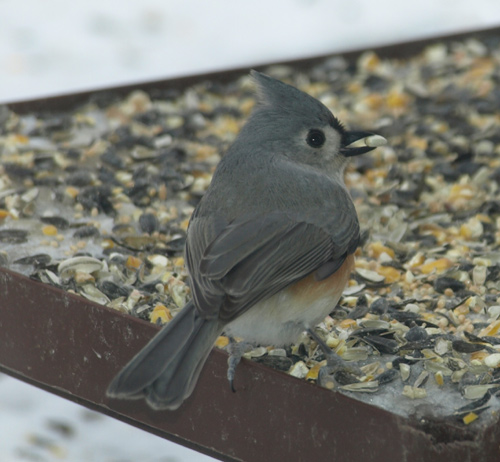Tufted titmice are perky little birds and frequent visitors to backyard feeders. Their colors are muted, but they are worth a second look because they are really quite pretty. Their top feathers are a soft gray, their breast is white, and they have a soft blush of rosy pink or orangish pink under their wings. These birds have a tuft, or crest, of gray feathers on their head. Their beaks are black.
Tufted titmice will chirp and scold and make various sounds, but one of the more common songs sung by the tufted titmouse is a whistle described as "peter peter peter". This is their courtship song. The link under the photo takes you to an example of this call on Cornell's birdcall website.
Tufted titmice are common through the eastern half of the US. These days they are year-round residents of Connecticut. Before 1940 these birds didn't live as far north as New England. They didn't used to range quite as far north as Maine, New Hampshire or Vermont. However they are pushing northwards and are now seen in the northern states of New England, even into southern Maine. It is thought that more people providing winter birdfeeders, warming climate, and the reforestation occurring as farming has decreased here over the last century have enabled them to move into our more northern area.
Tufted titmice inhabit deciduous forests, parks and are common in residential areas.
Tufted titmice eat seeds, nuts, and insects. They can hold down shelled items with their feet and peck them open. They like sunflower seeds and peanuts and will eat suet.
In Connecticut tufted titmice begin to sing their courtship song in early spring. Whistling repetitions of "peter peter peter!", "peter peter peter!" many times in a row are heard most often in March and are sung mostly by the males. A pair of titmice mate for life. In spring, usually May or June but sometimes earlier, nesting begins. The female waits at the chosen nest site and the male gathers twigs for nesting material. He lands on her back to deliver his finds and she weaves them into a loose nest. These birds will often use existing tree cavities as a nesting site. 5 or 6 eggs are usually laid, and the pair raises one family per season. From about mid-morning through the late afternoon the male does incubation duty. The rest of the time the female sits on the nest. Tufted titmice tend to occupy their territory as a pair, sometimes with one or a few of their recent young, in the summer and fall. In winter they will join mixed-species flocks. You can often see them in such groups at your winter feeder, in the company of nuthatches, chickadees, juncos and so forth.
